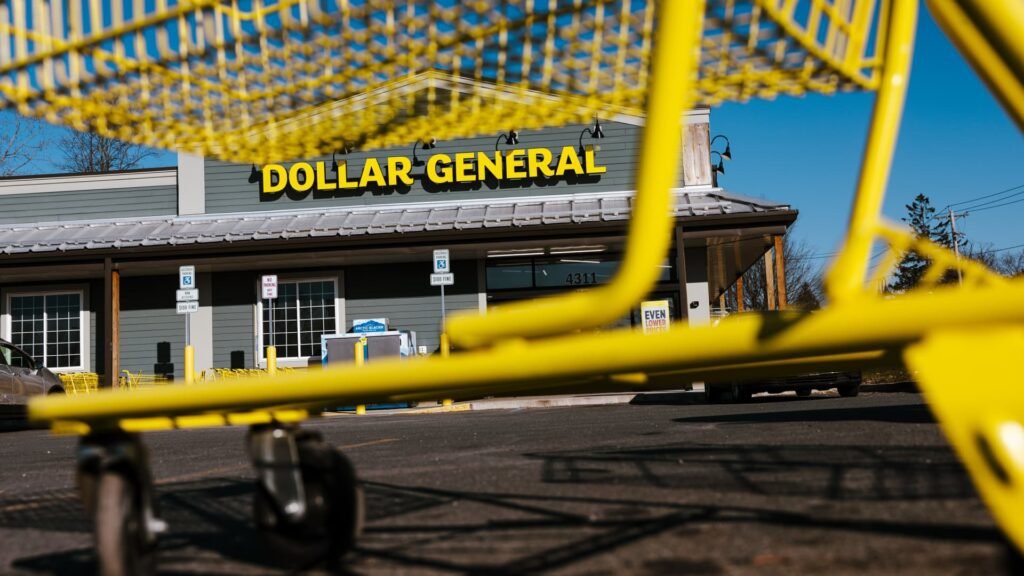A Dollar General store in Germantown, New York, Nov. 30, 2023.
Angus Mordaunt/Bloomberg via Getty Images
According to the Consumer Financial Protection Bureau, three of the nation’s largest retailers — Dollar General, Dollar Tree and Kroger — charge customers who ask for “cash back” at checkout more than $90 million a year in fees.
Many retailers offer cash back options to consumers who pay for their purchases with a debit or prepaid card.
But a CFPB analysis released Tuesday said charging fees for the service could be “exploitative” to certain customers, especially those who live in so-called banking deserts, who don’t have easy access to a bank branch or the ability to withdraw cash for free.
The CFPB said these trends tend to disproportionately affect rural areas, low-income families and people of color.
Cash-back fees are not charged by all retailers and can range from $0.50 to more than $3 per transaction, according to the bureau, which in recent years has been cracking down on financial institutions that charge so-called “junk fees.”
More information on personal finance:
The IRS’ “last resort” to collect delinquent taxes
How investors should prepare for low interest rates
Why remote work is here to stay
Five of the eight companies surveyed by the CFPB offer free cash back.
These include grocer Albertsons, drugstore chains CVS and Walgreens, and discount retailers Target and Walmart. (Kroger has proposed a $25 billion merger with Albertsons in 2022, but that deal is pending in court.)
“The fees to get cash back are just pennies that add up,” said Adam Last, director of financial services at the Consumer Federation of America, a consumer advocacy group.
“It just makes life harder,” he said. “You get thousands of little cuts all at once.”
Luis Alvarez | Digitalvision | Getty Images
A Dollar General spokesman said cash back offers help customers save money compared to “non-retail alternatives” like check cashing and ATM fees.
“Dollar General is not a financial institution, but we offer cash back options at more than 20,000 stores across the U.S. as a service to customers who don’t have easy access to major financial institutions,” the spokesperson said.
Spokespeople for Kroger and Dollar Tree, which operates Family Dollar and Dollar Tree stores, did not respond to CNBC’s requests for comment.
Kroger, Dollar General and Dollar Tree are the fourth-, 17th- and 19th-largest retailers in the U.S., respectively, in terms of sales in 2023, according to the National Retail Federation, a trade group.
Cashback is popular
The practice of charging a fee for cash back is relatively new, Last explained.
For example, Kroger Co. in 2019 instituted a fee of $0.50 on cash back purchases under $100 and $3.50 on amounts between $100 and $300, according to the CFPB.
This was true across brands such as Kroger, Fred Meyers, Ralph’s, QFC and Pick ‘N Save.
However, according to the CFPB, Kroger will begin charging a cash back fee for its Harris Teeter brands starting in January 2024, with a $0.75 fee on purchases under $100 and a $3 fee on purchases up to $200.
Cash withdrawals from retailers are the second most popular way to obtain cash, accounting for 17% of transactions from 2017 to 2022, according to an analysis of the CFPB’s “Diary and Survey of Consumer Payment Choices.”
The most popular was ATMs, at 61%.
But the CFPB and consumer advocacy groups say there are some key differences between withdrawals at retail stores and ATMs.
For example, they said the relatively low cashback limits make it difficult to spread the fees over larger withdrawals to limit their impact.
According to the CFPB, the average cash withdrawal at retail stores from 2017 to 2022 was $34, compared with $126 at ATMs.
Banking deserts are expanding
But for consumers living in banking deserts, retailers may be the only reasonable way to get cash, experts say.
According to the Federal Reserve Bank of Philadelphia, by 2023, more than 12 million people, or about 3.8% of the U.S. population, will live in bank deserts.
This figure is up from 11.5 million in 2019, or 3.5% of the population.
Generally, a bank desert is a geographic area with no local bank branches — people who don’t live within 10 miles of a physical bank branch. The rise of digital banking, accelerated by the coronavirus pandemic, has led many banks to close their brick-and-mortar locations, according to Lari Shaffer, a payments risk expert at the Federal Reserve Bank of Atlanta.
These deserts “are likely to hit vulnerable populations” who already have less access to online and mobile banking, she wrote recently.
Retailers blame banks
Retail advocates say banks are to blame for cash-back fees.
Every time a customer makes a purchase with a debit or credit card, the merchant must pay a fee to the bank, which can be, for example, 2% to 4% of the transaction.
Because the cashback amount is included in the total transaction price, the retailer also pays a fee to the bank for the cash the consumer requests.
Doug Cantor, general counsel for the National Association of Convenience Stores and a member of the Merchant Payments Coalition’s executive committee, said the “vast majority” of retailers don’t charge a fee for cash back and are suffering financial losses by offering the service for free to customers.
“Banks are abandoning a lot of these communities and ripping off retailers just by taking people’s cards and giving them cash,” he said.
But consumer advocates say this calculation ignores the benefits retailers derive from offering cash back.
“They’ll see it as a free way to gain customers. [the] “Without bank branches, they’re closing down,” Mr. Last said. “Instead, they’re charging even more unfair fees.”




